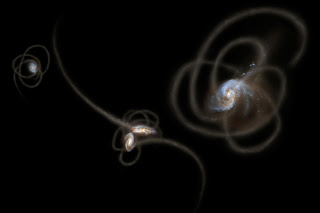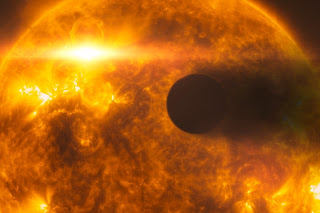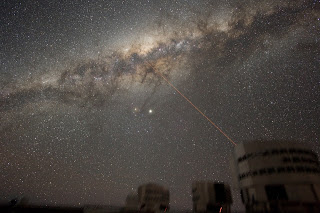PIA16216: Spitzer Sees Stray Starlight (Artist's Concept) New research from scientists using NASA's Spitzer Space Telescope suggests that a mysterious infrared glow across our whole sky is coming from stray stars torn from galaxies. When galaxies grow, they merge and become gravitationally tangled in a violent process that results in streams of stars being ripped away from the galaxies. Such streams, called tidal tails, can be seen in this artist's concept.
Astronomy, Physics, Geology, Biology, and other applications of scientific principles
Tuesday, October 30, 2012
PIA16216: Spitzer Sees Stray Starlight
Curious spiral spotted by ALMA around red giant star R Sculptoris
Observations using the Atacama Large Millimeter/submillimeter Array (ALMA) have revealed an unexpected spiral structure in the material around the old star R Sculptoris. This feature has never been seen before and is probably caused by a hidden companion star orbiting the star. This slice through the new ALMA data reveals the shell around the star, which shows up as the outer circular ring, as well as a very clear spiral structure in the inner material. Credit:ALMA (ESO/NAOJ/NRAO)/M. Maercker et al.
Wednesday, October 24, 2012
PIA15817
A dying star is throwing a cosmic tantrum in this combined image from NASA's Spitzer Space Telescope and the Galaxy Evolution Explorer (GALEX), which NASA has lent to the California Institute of Technology in Pasadena. In death, the star's dusty outer layers are unraveling into space, glowing from the intense ultraviolet radiation being pumped out by the hot stellar core. This object, called the Helix nebula, lies 650 light-years away, in the constellation of Aquarius. [...]
Tuesday, October 23, 2012
Got Mole?

Happy Mole Day!
Celebrated annually on October 23 from 6:02 a.m. to 6:02 p.m., Mole Day commemorates Avogadro's Number (6.02 x 10^23), which is a basic measuring unit in chemistry. Mole Day was created as a way to foster interest in chemistry. Schools throughout the United States and around the world celebrate Mole Day with various activities related to chemistry and/or moles.
For a given molecule, one mole is a mass (in grams) whose number is equal to the atomic mass of the molecule. For example, the water molecule has an atomic mass of 18, therefore one mole of water weighs 18 grams. An atom of neon has an atomic mass of 20, therefore one mole of neon weighs 20 grams. In general, one mole of any substance contains Avogadro's Number of molecules or atoms of that substance. This relationship was first discovered by Amadeo Avogadro (1776-1858) and he received credit for this after his death.
Make sure to have some yummy guacamole to celebrate too!
Friday, October 19, 2012
Exoplanet Tau Boötis b
This artist's impression shows the exoplanet Tau Boötis b. This was one of the first exoplanets to be discovered back in 1996, and it is still one of the closest planetary systems known to date. Astronomers using ESO's Very Large Telescope have now caught and studied the faint light from the planet Tau Boötis b for the first time. By employing a clever observational trick the team find that the planet's atmosphere seems to be cooler higher up, the opposite of what was expected. Credit: ESO/L. Calçada. Tap © to visit the web site.
Stellar flare hits HD 189733b
This artist's impression shows exoplanet HD 189733b, as it passes in front of its parent star, called HD 189733A. Hubble's instruments observed the system in 2010, and in 2011 following a large flare from the star (depicted in the image). Following the flare, Hubble observed the planet's atmosphere evaporating at a rate of over 1000 tonnes per second. In this picture, the surface of the star, which is around 80% the mass of the Sun, is based on observations of the Sun from the Solar Dynamics Observatory. Credit: NASA, ESA, L. Calçada. Tap © to visit the web site.Find more pictures and learn more about the Universe in Star Walk app for iPhone and in Star Walk app for iPad
Wednesday, October 17, 2012
Large bright fireball with orange-green tail breaks apart over Queensland, Australia, 29 August 2012
29 Aug 2012 – Ann Tanner and Alfie Coghill, Brisbane, Queensland 8.15pm
Less than 5 seconds' visibility, facing North. North – East direction. Bright white ball of fire, brighter than the moon. Large, round, white ball of fire, dropped at speed from the sky. Biggest shooting star I've ever seen!
29 Aug 2012 – Jak Yeppoon, Capricorn Coast, Queensland, Australia 20.20pm/aest
4 seconds – Went behind mountain. North – West. I was facing West. Very bright green and an orange tail at the end. As bright as a weld flash solid… clean line, amazing.
29 Aug 2012 – Michael Klazema & Lisa Eroshkin Mackay, Queensland, Australia 20:15 EST
3/4 sec – NE-SW. White fireball with a short white tail with debris of green and orange bits falling off. Very large bright star. On its travel a short distance from the horizon there appeared to be a short break in the light but reappeared instantaneously before fading out on the horizon.
Monday, October 15, 2012
STEREO catches an eruptive prominence
Via Jenny Winder on Google+ I saw this way cool video of an eruptive prominence on the Sun: a towering arc of plasma held aloft by the Sun's magnetic fields. Sometimes these field lines are unstable, and the plasma can blast away from the Sun and out into space:
This video was taken by one of NASA's twinSTEREO spacecraft; a pair of probes with one orbiting well ahead and the other behind the Earth. They stare at the Sun, literally giving us an angle on it we can't get from our planet. Specifically this was from the STEREO Ahead spacecraft, and combines an ultraviolet view of the Sun itself together with a visible light portion that shows the Sun's outer atmosphere, called the corona.
You can see the prominence form, rise up, and then erupt away into space over the course of one day, on October 6-7, 2012. Sometimes this material rains back down to the surface, and sometimes it escapes entirely. When it does the latter, it can flow outward, impact the Earth, and cause a geomagnetic storm. Usually those do us no harm, though if they get big they can disrupt satellites and potentially cause power outages. More likely they just create gorgeous auroraewhich can be photographed from the ground.
It's actually rather amazing how many space-based eyes we have on the Sun and the amount of data they send back. The Sun is a feisty beast, and getting feistier as we approach the maximum part of its magnetic cycle. The more we observe it, the more we learn, and learning is always good.
Original Page: http://feedproxy.google.com/~r/BadAstronomyBlog/~3/i8qNu1JDEUk/
Asteroid Vesta
There's some topics on Astronomy Cast that we wait until we are good and ready, until the science is all in. The Dawn mission has completed it's mapping operations at asteroid Vesta and it's now moving on to Ceres. This gives us a great opportunity to take a detailed look at this amazing asteroid, report on the science findings, and give you a preview of what's coming next.
Original Page: http://www.astronomycast.com/2012/10/ep-274-vesta/
Meet a science committee that doesn't get science
And from the Show-Me (how to think) state, we have another reason that government is always the last option for anything.In general, we only become aware of a politician's position on scientific issues during the campaign season. And, with a few exceptions like energy and climate policy, they rarely become campaign issues for anyone other than presidential candidates. So for the most part, it's rare to have a good picture of what our elected representatives think about science and technology.
If only that were true this year.
Missouri's Todd Akin, a Representative running for Senator, made headlines through his bizarre misunderstanding of biology, specifically that of the female reproductive system. Overcome by his desire to believe that pregnancy (and thus abortion) shouldn't be an issue for rape victims, he infamously claimed that the female body could somehow block pregnancy in the case of "legitimate rape."
Original Page: http://arstechnica.com/staff/2012/10/editorial-meet-a-science-committee-that-doesnt-get-science/
Wednesday, October 10, 2012
Mega Starbirth Cluster
This illustration shows an artist's impression of the so-called Lynx arc, a newly identified distant super-cluster that contains a million blue-white stars twice as hot as similar stars in our Milky Way galaxy. The Lynx arc is one million times brighter than the well-known Orion Nebula, a nearby prototypical 'starbirth' region visible with small telescopes. The stars in the Lynx arc are more than twice as hot as the Orion Nebula's central stars, with surface temperatures up to 80 000›C. Though there are much bigger and brighter star-forming regions than the Orion Nebula in our local Universe, none are as bright as the Lynx arc, nor do they contain such large numbers of hot stars. The stars are so hot that a very large fraction of their light is emitted in the ultraviolet that makes the gas glow with the green and red colours illustrated here.
Monday, October 8, 2012
The Music of the Primes
Little-scale offers music procedurally-generated from prime numbers. A "full version", available for download, is 26 hours long.
Original Page: http://feeds.boingboing.net/~r/boingboing/iBag/~3/3bdZFTI19Kk/the-music-of-the-primes.html
Friday, October 5, 2012
Astronomy: Good Night, Vega
The Planet, the Galaxy and the Laser
Image of the night sky above Paranal on 21 July 2007, taken by ESO astronomer Yuri Beletsky. A wide band of stars and dust clouds, spanning more than 100 degrees on the sky, is seen. This is the Milky Way, the Galaxy we belong to. At the centre of the image, two bright objects are visible. The brightest is the planet Jupiter, while the other is the star Antares. Three of the four 8.2-m telescopes forming ESO's VLT are seen, with a laser beaming out from Yepun, Unit Telescope number 4. The laser points directly at the Galactic Centre. Also visible are three of the 1.8-m Auxiliary Telescopes used for interferometry. They show small light beams which are diodes located on the domes. The exposure time is 5 minutes and because the tracking was made on the stars, the telescopes are slightly blurred. Credit: ESO/Yuri Beletsky. Tap © to visit the web site.Find more pictures and learn more about the Universe in Star Walk app for iPhone and in Star Walk app for iPad
Wednesday, October 3, 2012
Have you vaccinated your children yet?
Wouldn't it be great if science were finally able to eradicate superstition and ignorance throughout the world?
I don't even think I would miss the Republicans.
The Immoral Minority: Have you vaccinated your children yet?
Monday, October 1, 2012
New comet might blaze brighter than the full Moon
A new comet has been discovered that is predicted to blaze incredibly brilliantly in the skies during late 2013. With a perihelion passage of less than two million kilometres from the Sun on 28 November 2013, current predictions are of an object that will dazzle the eye at up to magnitude —16. That's far brighter than the full Moon. If predictions hold true then C/2012 S1 will certainly be one of the greatest comets in human history, far outshining the memorable Comet Hale-Bopp of 1997 and very likely to outdo the long-awaited Comet Pan-STARRS (C/2011 L4) which is set to stun in March 2013.
The new comet, named C/2012 S1 (ISON) was found by the International Scientific Optical Network (ISON) in Russia on 21 September when astronomers Vitali Nevski and Artyom Novichonok captured it on CCD images taken through a 0.4-metre reflector. Its near-parabolic orbit suggests that it has arrived fresh from the Oort Cloud, a vast zone of icy objects orbiting the Sun, pristine remnants of the formation of the Solar System.
C/2012 S1 currently resides in the northwestern corner of Cancer. At magnitude +18 it is too dim to be seen visually but it will be within the reach of experienced amateur astronomers with CCD equipment in the coming months as it brightens. It is expected to reach binocular visibility by late summer 2013 and a naked eye object in early November of that year. Northern hemisphere observers are highly favoured. Following its peak brightness in late November it will remain visible without optical aid until mid-January 2014.
Comet brightness predictions sometimes exceed their performance. Amateur astronomers of a certain age may remember the Comet Kohoutek hype of 1973 – not quite the 'damp squib' it has been portrayed, since it reached naked eye visibility! Even if C/2012 S1 takes on the same light curve as Kohoutek it is certain to be spectacular, quite possibly a once-in-a-civilisation's-lifetime event.









